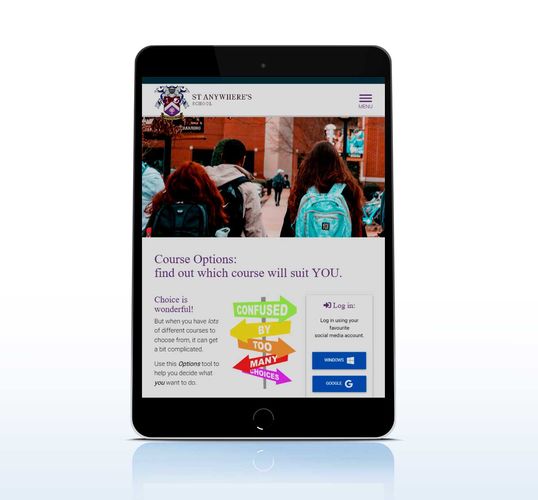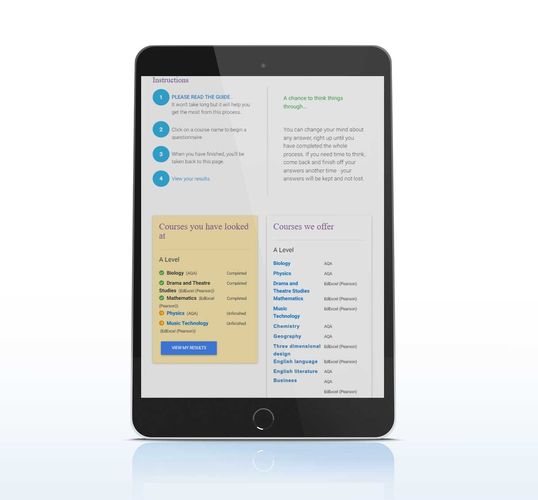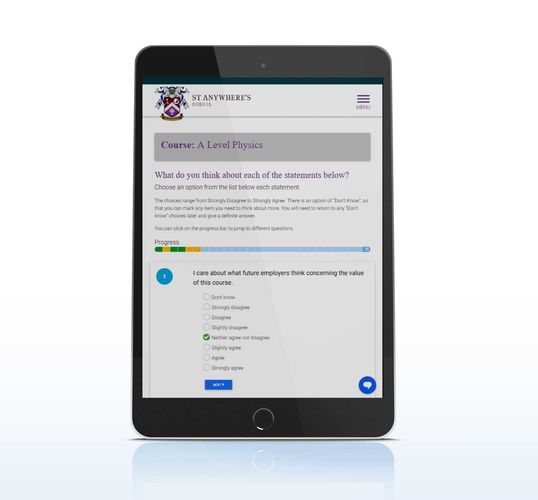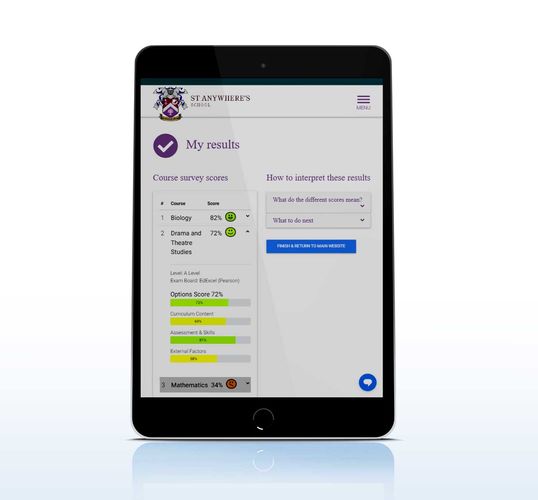What it does
Options helps students make successful course choices.
Making the right choices about the courses taken post-16 is important. But students often find this difficult and can struggle to take decisions they are confident about. Poor course choice can lead to several negative outcomes. Options is here to help & enable students to choose successfully.




Options is a really simple web based interactive tool...
It leads students to consider & reflect more objectively about their post-16 choice choices, allowing them to understand what they are signing up for and honestly assess which courses on offer are really best for them.
For schools & colleges, Options is customised to integrate with and compliment existing marketing and recruitment systems. It also provides valuable data that can lead to further improvements in these.
...based on three key ideas drawn from research in post-16 education:
- Poor course choice is the prime cause of student drop-out. [1]
- Successful attainment is strongly linked to students' motivation towards the contents of their chosen courses. [2]
- Even though course specific information is provided, most students do not carefully read it or use it when making their course choices. [3]
Students often don't understand what a course will be like to study
Information about courses in prospectuses is often too brief. But students often only look at detailed information sheets after a decision to study a course has been made. Only the very diligent read and reflect on the 500-1000 words they contain.
Many of the courses, students have never studied before. Without careful consideration of course content, their perceptions about the course experience can be far from reality.
I thought A-Level Psychology would be more related to criminology.
I was good at GCSE History and enjoyed it. I didn’t realise how different the A-Level would be & all
the political stuff in the course.
How it works
Simplicity is key
The value is in the process itself, which leads students to realise just how much they do or do not know about what they are signing up for.
A link from your school/college website takes students to an Options log-in page, branded to blend with your current course marketing. Students sign-in and find links to simple surveys, one for each course you offer, tailored to reflect your course module selections. The surveys, derived from syllabus specification documents, summarise key points of course content and assessment and are designed to help students reflect on the strength of their interest and potential motivation. We add some other helpful questions and provide instant feedback on the scores for each course in rank order. The higher their score, the more confident the student can be about their genuine strength of their interest in the course.
Think without pressure.
Students' scores are stored - they can take their time to think and research course ideas in order to complete surveys in their own time and pace. They can return later to finish off surveys, take additional surveys, re-do questionnaires. Clear guidance is provided with feedback to help students understand the significance of their scores, along with advice on what they could do next to explore their course preferences further.
Outcomes
Clear ideas about course content build study preparedness, which improves student success.
When students have clear ideas about course content it builds their confidence & encourages positive study preparedness, improving their success & reducing the doubts which can lead to drop-out, course changes and lack of motivation.
Students find the Options tool helpful and user friendly.
Helping students to engage with course content and reflect about their choices is the key to improving successful enrolment choices and will contribute to improving success rates. What makes Options unique is that students learn about the actual courses offered in centres, not making decisions based on vague generic information that can confuse further.
Options data can help improve course delivery & student attainment
Options provides data on student interest & course motivation at cohort level, including 'Class' and 'Course content' profiles, offering valuable insights for planning & evaluation of course delivery. This provides invaluable information to triangulate understanding of course performance along with attainment, value-added and retention data.
The data collected are rich in detail. The reporting module with the administrator’s page can create profiles for each groups of students and/or classes. These highlight topics that students expect to find less interesting and more challenging. The profiles can be used to clarify the course study focus for students, to address potential difficulties during induction and identify course areas where additional lesson planning may be needed.
Using course profile data can enhance course information and marketing
Course profile data can also help improvement strategies, identifying differences between students' perceptions of a course and its actual contents. These misconceptions can be addressed through better information, advice and guidance, leading to improved recruitment as well as course achievement.
Our research reveals there is an "at risk" profile for each course. Following the first year of use, Options Education conduct statistical analysis of the data gathered to identify successful and unsuccessful student profiles for each course. These can then be factored into subsequent student feedback.










